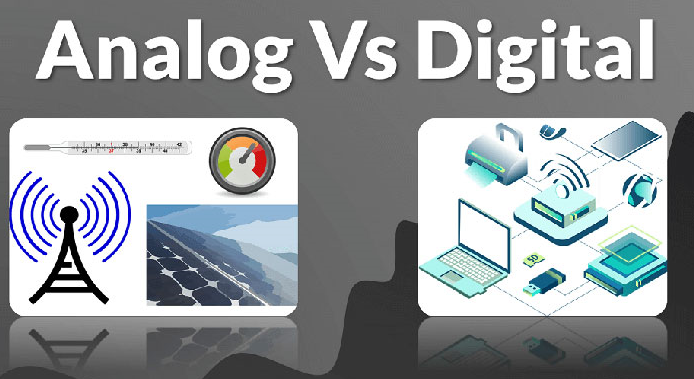Analog electronics focuses on the study and manipulation of continuous signals through circuits specifically designed to handle them. These signals can vary smoothly over a range, representing physical quantities like temperature, pressure, sound, or light intensity. Analog circuits use components like resistors, capacitors, inductors, and transistors to amplify, filter, or modulate these signals. Applications include audio amplifiers, radio receivers, and sensors for real-world measurements. Analog systems are valued for their high-resolution processing but are more susceptible to noise and distortion compared to digital systems.
Digital electronics is a branch of electronics that deals with discrete signals represented in binary form (0s and 1s). It uses components like logic gates, flip-flops, microprocessors, and memory to process, store, and transmit digital data. Digital circuits are less susceptible to noise, allow for precise operations, and are widely used in devices like computers, smartphones, digital watches, and IoT systems. They enable fast, efficient, and reliable processing of information.
Analog vs Digital Electronics: Key Differences and Comparison
| Feature | Analog Electronics | Digital Electronics |
| Signal Type | Processes continuous signals. | Processes discrete signals (binary: 0 and 1). |
| Representation | Uses waveforms or continuously varying signals. | Uses binary numbers (0s and 1s). |
| Examples of Signals | Audio signals, temperature, pressure. | Computer data, digital audio, and images. |
| Accuracy | High resolution with theoretically infinite precision. | Limited by step size; approximations are common. |
| Complexity | Relatively simple circuits but prone to noise. | More complex circuits but less affected by noise. |
| Components | Resistors, capacitors, inductors, transistors, diodes. | Logic gates, flip-flops, microprocessors, memory chips. |
| Applications | Audio amplifiers, radio tuners, temperature sensors. | Computers, digital watches, smartphones, microcontrollers. |
| Noise Susceptibility | Highly susceptible to noise and signal degradation. | Less affected due to discrete nature of signals. |
| Signal Manipulation | Difficult to process, requiring analog circuitry. | Easier to process with algorithms and digital circuitry. |
| Storage | Stored using physical properties (e.g., magnetic tapes). | Stored as binary data in digital storage devices (e.g., SSDs). |
| Processing Speed | Limited by signal nature and physical properties. | Fast processing enabled by advanced digital systems. |
| Cost | Often less expensive for simple systems. | Typically higher due to complexity but decreasing with scale. |
| Power Consumption | Higher due to continuous operation. | Lower due to binary switching. |
| Error Correction | Difficult to implement. | Easier with error-detection and correction algorithms. |
Summary of Differences
- Nature of Signals: Analog systems deal with smooth, continuous signals, while digital systems handle binary data, enabling more robust processing and storage.
- Design and Complexity: Analog circuits are simpler but more susceptible to noise, while digital circuits are more complex yet provide higher accuracy and resilience.
- Applications: Analog systems excel in real-world measurements like temperature and sound, whereas digital systems dominate computing, communication, and modern technology.
Use Cases
- Analog Electronics: Audio amplifiers, radio systems, and sensors for temperature or pressure.
- Digital Electronics: Computers, IoT devices, smartphones, and digital communication systems.
Both analog and digital electronics are essential, often complementing each other in hybrid systems like analog-to-digital converters (ADCs) and digital-to-analog converters (DACs).






